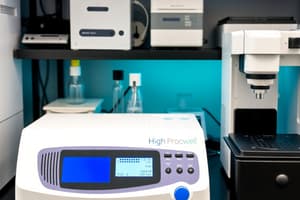Podcast
Questions and Answers
What is the term for a disease that can be transmitted from animals to humans?
What is the term for a disease that can be transmitted from animals to humans?
- Pandemic
- Emerging virus
- Zoonosis (correct)
- Epidemic
Which of the following is an example of a classification level in hierarchical classification?
Which of the following is an example of a classification level in hierarchical classification?
- Evolution
- Genus (correct)
- Natural selection
- Species diversity
What does natural selection primarily drive in an ecosystem?
What does natural selection primarily drive in an ecosystem?
- Establishment of an epidemic
- Occurrence of macroevolution
- Increase in species diversity
- Adaptations in organisms (correct)
Which term describes a significant increase in disease cases in a specific area?
Which term describes a significant increase in disease cases in a specific area?
What is the purpose of a dichotomous key?
What is the purpose of a dichotomous key?
What is the primary purpose of PCR?
What is the primary purpose of PCR?
Which part of a pipette is used to set the desired volume prior to use?
Which part of a pipette is used to set the desired volume prior to use?
What is Taq DNA Polymerase primarily used for in molecular biology?
What is Taq DNA Polymerase primarily used for in molecular biology?
What is the correct order of the three main steps in the PCR process?
What is the correct order of the three main steps in the PCR process?
Which of the following accurately describes introns and exons?
Which of the following accurately describes introns and exons?
What is the primary function of a vaccine?
What is the primary function of a vaccine?
Which of the following is NOT a source of DNA for PCR?
Which of the following is NOT a source of DNA for PCR?
Which of the following best defines biotechnology?
Which of the following best defines biotechnology?
Flashcards
Zoonosis
Zoonosis
A disease spreadable from animals to humans.
Emerging virus
Emerging virus
A virus that recently appeared in a population.
Natural Selection
Natural Selection
Process where organisms better adapted survive and reproduce.
Taxonomy
Taxonomy
Signup and view all the flashcards
Dichotomous Key
Dichotomous Key
Signup and view all the flashcards
PCR
PCR
Signup and view all the flashcards
Taq DNA Polymerase
Taq DNA Polymerase
Signup and view all the flashcards
PCR steps
PCR steps
Signup and view all the flashcards
Molecular Biology
Molecular Biology
Signup and view all the flashcards
Biotechnology
Biotechnology
Signup and view all the flashcards
Electrophoresis
Electrophoresis
Signup and view all the flashcards
Introns/Exons
Introns/Exons
Signup and view all the flashcards
RNA splicing
RNA splicing
Signup and view all the flashcards
Study Notes
Safety Lab
- Know laboratory safety protocols (appropriate clothing, etc.).
Pipetting Lab
- Always use a new tip for each sample, and avoid touching the tip to surfaces.
- Calibrate the pipette.
- Properly add and eject pipette tips.
- Choose correct pipette size based on volume needed.
- Set desired volume.
- Know the parts of a pipette (tip, plunger, volume adjustment knob, body).
- Demonstrate pipetting a specific volume to instructor.
PCR Lab One
- Molecular Biology: The study of biological processes at the molecular level.
- Biotechnology: The use of living systems and organisms for product development.
- PCR stands for Polymerase Chain Reaction.
- PCR objective: To amplify specific DNA sequences.
- Source of DNA: Blood, saliva, hair, and other bodily tissues.
- PCR impacts: Genetic testing, forensics, cloning, medicine, agriculture, and environmental science.
PCR Lab Two
- Components for PCR: DNA template, primers, nucleotides, and Taq polymerase.
- Taq DNA Polymerase: A heat-stable enzyme for DNA synthesis.
- PCR steps: Denaturation, annealing, and extension.
PCR Lab Three
- Introns: Non-coding regions in genes.
- Exons: Coding regions of a gene.
- RNA splicing: The process of removing introns and connecting exons in mRNA.
- Homozygous positive: Two identical dominant alleles.
- Homozygous negative: Two identical recessive alleles.
- Heterozygous: One dominant and one recessive allele.
- DNA electrophoresis: A technique used to separate DNA fragments by size.
Viral Transmission Lab
- Mode of transmission: How a virus spreads to a new host.
- Vaccine function: Providing immunity against specific pathogens.
Natural Selection Lab
- Macroevolution: Large-scale evolutionary changes over time.
- Natural selection: Organisms better adapted to their environment survive and reproduce.
- Evolution: Change in heritable characteristics in biological populations over successive generations.
- Predator-prey relationships: Predatory pressure that drives evolutionary adaptations in both.
Taxonomy and Dichotomous Keys
- Taxonomy: Science of classifying living organisms).
- Nomenclature: A system of naming organisms.
- Hierarchical classification: Domain, kingdom, phylum, class, order, family, genus, species.
- Dichotomous key: Tool for identifying organisms through a series of choices.
Ecological Applications Labs
- Species diversity: Variety of different species in a given area.
- Hypothesis: A testable prediction about the relationship between variables.
- Specific animals observed: This part of the notes depends on the animals observed in a campus experiment, and this is not present in the document.
Studying That Suits You
Use AI to generate personalized quizzes and flashcards to suit your learning preferences.




